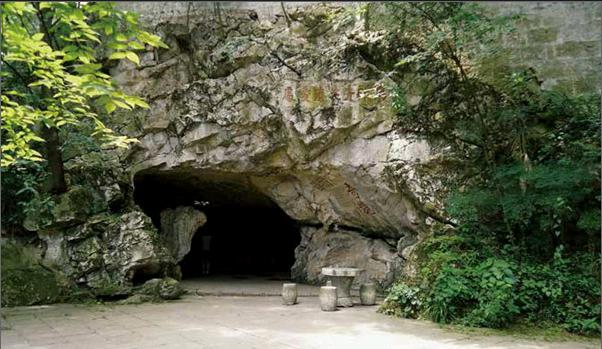走一走修文阳明洞
2017-01-10罗罗
罗罗

从贵阳去修文几十里地,一路望山,可以怀想悠悠往事。
从前,修文一带是五方杂处的穷乡僻壤。明代初,彝族之女奢香夫人继丈夫之业摄理贵州宣慰使一职,期间凿空龙场九驿,从此马帮铃声回响山谷间。正德初,兵部主事王阳明因抗章遭贬,万里投荒,于三年(1508)到九驿第一站龙场驿任驿丞。他在这里传播文化,冥思旧学,萌生新说,从而树立起中国思想哲学发展道路上的历史性里程碑。
龙场驿归兵部管辖,不过其时彝人安氏土司正想废去,仅配“丞一名,吏一名,马二十三匹”(民国《贵州通志·建置》),破败得连住宿都没有。王阳明自言“初至龙场,无所止,结草庵居之”,因作五古一首:“草庵不及肩,旅倦体方适。开棘自成篱,土阶漫无级。迎风亦萧疏,漏雨易补缉。灵濑响朝湍,深林凝暮色……污樽映瓦豆,尽醉不知夕。缅怀黄唐化,略称茅茨迹。”驿站边的临时草庵简陋穷酸,但他似乎不介意,浏览景物,杯酒释怀,尚存高古心地。
龙场驿以及草庵地处今天的修文县城南隅,如今已不在——其实在与不在无所谓,王阳明“龙场悟道”的遗痕在城东栖霞山上。现在,栖霞山前建了一座文化园,望过去,竖着白石牌坊和青钢雕像。园内一部分为广场,一部分为纪念馆,我进馆买得一本王阳明诗文的选本。当然,山上是游览重点,已经整治。
入山门行走渐深,杂树为主,偶尔一二黄叶飘落,生发出丝丝荒岗野村稀落萧索的气息,有那种还原历史人文的真味道。上一段笔直的石磴道,山腰就是阳明洞。快到洞前,有两株传为王阳明手植的老苍柏树,接天而去已500有余年。
王阳明在龙场做学问,以阳明洞为代表。估计驿站公事不多,便想清静而可以思想,他很快离弃草庵,跑到这山上的东洞里面又搭了一间草窝,玩起大道之源、五经之首的《周易》。“阳明子之居夷也,穴山麓之窝而读《易》其间……名其窝曰‘玩易。”(《玩易窝记》)他自述自己仰头埋头地思索,这个洞特别窄小,外面却辽阔浩渺。在这里读《易》,可以悠然地学习和休息,自然而然就有一种新的感觉,这是整理的结果。古人说《易》是天、地、人都具备的一本好书,学习它,是研究人的精神和智慧。孔子读《易》,韦编三绝,用这种精神将使研究更加深入透彻。
东洞欠些宽敞,倒还明亮,搭间草窝读书别有情趣,冥想时能面壁石钟乳。据说,由《易》而《诗》《书》《礼》《春秋》,王阳明在这里注解集成了他的第一部哲学专著《五经臆说》。他认为,对五经原旨的解读,不必拘泥于古人,由此大彻大悟了“心即理”,为之后构建“致良知”思想、“知行合一”学说的理论框架、集心学之大成做下基本准备。
东洞后称“阳明小洞天”,有许多颂扬的石刻,我看了一些也忘了一些,只记得别人说,洞口藤萝倒垂处有奢香夫人的后人、贵州宣慰使安国亨的摩崖“阳明先生遗爱处”最出名,旁边的“阳明别洞”及“奇境”次之。也许说得对,摩崖的作用往往在于让有意义的东西不朽而千古。
离阳明洞不远的何陋轩,是王阳明正式的居所。他曾作《何陋轩记》,写道:东峰石穴,又阴以湿,“龙场之民……相与伐木阁之材,就其地为轩以居予”。这居所仅三开间,却不简单,王阳明在这里生活得非常富足:他种竹莳花,弹琴编书,当地学士渐渐来游,安氏土司有酒肉相济,“因名之曰‘何陋,以信孔子之言”。孔子曰:“君子居之,何陋之有?”王阳明说,偏僻乡民如未琢之璞、未绳之木,虽粗砺顽梗,也可以椎斧,为什么轻视他们呢?孔子不也一样看待自己“欲居九夷”吗?这里的风俗崇巫而事鬼、渎礼而任情,是无人讲典章文物之故。只要有君子居住,开化他们也容易。王阳明于是有讲学之举,而讲学是最好的做学问,历来如此。
王阳明愿学夫子“为君子儒,无为小人儒”,在何陋轩前“驾楹为亭,环植以竹,而名之曰‘君子”,著文《君子亭记》说明“竹有君子之道四焉”:中虚而静,通而有间,为“德”;外节而直,柯叶无改,为“操”;应蛰而出,遇伏而隐,为“时”;揖逊俯仰,若洙泗群贤之交集,挺然特立,若虞廷群后之侧列,为“容”。贵州最多竹子,他透过竹子看万山风景,确实看出了必须反动于朱子理学的道道来。
王阳明讲学的地方在栖霞山顶,却叫“龙冈书院”。那本诗文选本里没有王阳明作的“记”,不清楚他如何办起书院、召集学生讲学。他曾经给他的学生写过一封信,提到了亲传的第一批弟子17人的名字。学说传播在很大程度上是通过书院起作用。从贵州龙冈书院(文明书院)到江西濂溪书院再到浙江稽山书院,构成了王阳明学说的传播路线,后世国内各学派和日本的阳明学、朝鲜的实学以及东南亚和欧美的王学,都以龙冈为渊薮。他的教育思想,也发端于龙场,《龙场诸生问答》和《教条示龙场诸生》便在这里奠基。
还在明之嘉靖中,龙冈书院已成旧址,其上重建了纪念专祠,清乾隆、嘉庆、道光、光绪及民国时期历有修治,前人敬仰推崇如此。现在祠的总体建筑结构一仍如旧,正殿为享堂,20世纪90年代有日本人捐了王阳明铜像,并恢复原有匾额及楹联。东厢是张学良囚禁处,他曾被迫在这里读阳明学说。西厢两次间有王阳明《龙冈漫兴》《西园》《龙场草庵》《阳明小洞天》诗碑6通。元气亭挂“培养元气”匾,原是举行祭祀时的乐舞场所。
漫步龙冈书院外,当年迎宾待客的宾阳堂有复构。《书·尧典》曰“寅宾出日”,孔颖达疏作“恭敬导引将出之日”,王阳明取名何谦谦。宾阳堂附近尚有大佛殿。以前的官员认为祠堂之侧不宜寺院,命令迁走,留下二三佛子照看王文成公祠。嗟乎礼义,僭越不得。
据说,王阳明振铎贵阳文明书院时,其“知行合一”的学说仿佛隐隐山风,那么,至少“致良知”的思想在龙冈书院已经萧萧有声。小时候习《古文观止》,记得收了王阳明的《瘗旅文》《象祠记》,前篇写伤人客死、悲情真挚,后篇写君子修德、感化深切,至今尚能背诵。这一文一记都是他在龙场时期阐发“致良知”思想的形象化的论文。这次看了选本中《与安宣慰书》三篇,尤其其二,感到也接触他的观点,又读《远俗亭记》《卧马家记》和一些秀逸有致的诗作,一样有意思。
人说,研究孔孟必到山东,研究二程必到河南,研究朱熹必到江西,研究王阳明不能不到贵州、不能不到修文、不能不到阳明洞。从贵州回来没几天,报载浙江柯桥的稽山书院复建开院,什么时候也应该去走一走,包括余姚的阳明故居、兰亭的阳明墓,与修文行合并作一次读书之旅。
(本文照片由梁凤英提供)
It is about 20 kilometers from Guiyang to Xiuwen. I went there to visit Longchang where Wang Yangming (1472-1529) stayed for more than three years. In 1508 he was exiled to the remote Longchang in the southwestern China from the dynastys capital. Xiuwen had used to be a sparsely populated region. Then nine outposts were developed and trade routes extended. Longchang was the first of the nine in the wilderness. The outpost in Longchang was nothing to write home about. As the governor, Wang had only one employee working under him and twenty-three horses. Upon arrival, he found he had nowhere to stay. He built a thatched hut and made it his home.
“Contemplating Truth in Longchang” is a key chapter in the history of Chinese philosophy and culture and makes Longchang famous. Longchang and the hut where Wang stayed are long gone, but there is a cave in Qixia Hill to the east of the countys capital where Wang Yangming did his contemplation. This is the destination for pilgrims like me. There is a park in front of the hill. Inside the park stand a white stone memorial archway and a bronze statue. The park is composed of a public square and a memorial museum. I bought a selection of poems and essays of Wang Yangming at the museum.
Through the archway I went to the hill. The forest was dense. After a long flight of steps I came to Yangming Cave and saw two towering cypress trees nearby. Presumably they were planted by the philosopher himself. If the story is true, then the two trees are more than 500 years old.
The cave was where Wang worked out his system of philosophy. As he did not have a tight official work schedule in such a remote place, he deserted the hut and came here. He studied classics here and wrote a thick heap of notes. On the basis of the notes, he wrote a book on his philosophy. Longchang was where his unprecedented ideas were first conceived, though not yet fully fledged.
He had a house built not far from the cave. He wrote a short essay about the three-room house and a relatively good life he enjoyed there. He planted flowers and bamboo there; he edited his essays and notes and played the Qin. Scholars came to visit him from far and the local chief provided wine and meat. As a scholar, he decided to teach local people about Confucianism.
He set up a school at the top of Qixia Hill and named it Longgang Academy. The book I had bought at the museum does not explain the details of the school: when it started and how students came to him. In a letter he wrote to a student, he mentioned that he recruited 17 locals when the school started. His ideas spread through the lectures he gave. In his lifetime he ran three academies: Longgang Academy in Guizhou, Lianxi Academy in Jiangxi and Jishan Academy in Zhejiang. The three schools constituted a road map showing how he disseminated his ideology. The studies of his philosophy in Korea, Southeast Asia, Europe and America are all based on the ideas he conceived at Longgang. His thought about education can be seen clearly in the teachings he wrote at Longgang.
The academy at Longgang was long gong even in the Ming Dynasty and a memorial temple was set up on the site there to commemorate Wang Yangming. The temple was refurbished several times during the Qing Dynasty. The current structure retains the historical layout. In the 1990s, a bronze statue donated by Japan was set up there and plaques and couplets were restored. His poems written in Longgang can be seen on six stone steles in the west wing.
When I was a kid, I read two essays of Wang in a textbook compiled in the Qing Dynasty. I was deeply impressed. I can still recite the texts. The first text describes the death of someone far from home. The second essay relates the cultivation of virtues a man should do. The essays reflect the unity of knowledge and action, a theory that he conceived at Longchang.
I walked out of the academy and came to the guesthouse where the visitors to the academy once stayed. Nearby is a Buddhist temple. After the temple was constructed, local government thought its location inappropriate because it was offensive to the solemnity of the memorial temple of Wang Yangming. So monks were ordered to leave and only two or three were instructed to stay to take care of the memorial temple.
Leaving Longgang, I thought about the sites of Wang Yangming in Zhejiang. Now I am thinking of a journey to visit Jishan Academy in Keqiao, Shaoxing, the former residence of Wang Yangming in Yuyao, and his tomb in Orchid Pavilion in Shaoxing. My visit to Xiuwen County would be additionally meaningful if I can visit the philosophers home and academy and tomb in Zhejiang.
